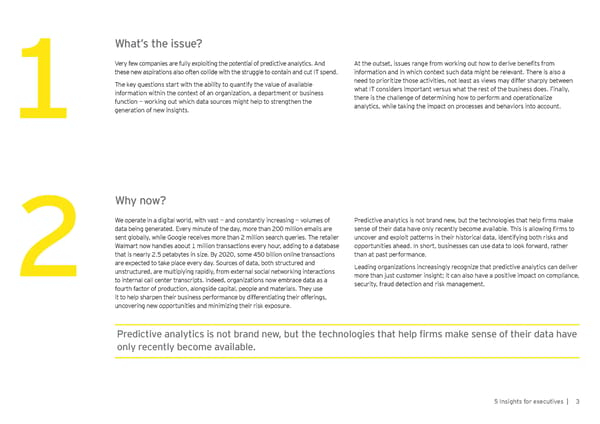What’s the issue? Very few companies are fully exploiting the potential of predictive analytics. And At the outset, issues range from working out how to derive benefits from these new aspirations also often collide with the struggle to contain and cut IT spend. information and in which context such data might be relevant. There is also a The key questions start with the ability to quantify the value of available need to prioritize those activities, not least as views may differ sharply between information within the context of an organization, a department or business what IT considers important versus what the rest of the business does. Finally, function — working out which data sources might help to strengthen the there is the challenge of determining how to perform and operationalize generation of new insights. analytics, while taking the impact on processes and behaviors into account. Why now? We operate in a digital world, with vast — and constantly increasing — volumes of Predictive analytics is not brand new, but the technologies that help firms make data being generated. Every minute of the day, more than 200 million emails are sense of their data have only recently become available. This is allowing firms to sent globally, while Google receives more than 2 million search queries. The retailer uncover and exploit patterns in their historical data, identifying both risks and Walmart now handles about 1 million transactions every hour, adding to a database opportunities ahead. In short, businesses can use data to look forward, rather that is nearly 2.5 petabytes in size. By 2020, some 450 billion online transactions than at past performance. are expected to take place every day. Sources of data, both structured and Leading organizations increasingly recognize that predictive analytics can deliver unstructured, are multiplying rapidly, from external social networking interactions more than just customer insight; it can also have a positive impact on compliance, to internal call center transcripts. Indeed, organizations now embrace data as a security, fraud detection and risk management. fourth factor of production, alongside capital, people and materials. They use it to help sharpen their business performance by differentiating their offerings, uncovering new opportunities and minimizing their risk exposure. Predictive analytics is not brand new, but the technologies that help firms make sense of their data have only recently become available. 5 Insights for executives | 3
 5 Insights for Executives Page 2 Page 4
5 Insights for Executives Page 2 Page 4